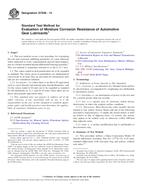We need your consent to use the individual data so that you can see information about your interests, among other things. Click "OK" to give your consent.
ASTM D7038-14
Standard Test Method for Evaluation of Moisture Corrosion Resistance of Automotive Gear Lubricants
STANDARD published on 1.10.2014
The information about the standard:
Designation standards: ASTM D7038-14
Note: WITHDRAWN
Publication date standards: 1.10.2014
SKU: NS-37384
The number of pages: 25
Approximate weight : 75 g (0.17 lbs)
Country: American technical standard
Category: Technical standards ASTM
Annotation of standard text ASTM D7038-14 :
Keywords:
corrosion, final drive axle, gear failure, gears, lubricants, L-33-1, moisture, rust, ICS Number Code 75.100 (Lubricants, industrial oils and related products)
Additional information
| Significance and Use | ||||||||||||
|
5.1 This test simulates a type of severe field service in which corrosion-promoting moisture in the form of condensed water vapor accumulates in the axle assembly. This may happen as a result of volume expansion and contraction of the axle lubricant and the accompanied breathing in of moisture-laden air through the axle vent. The test screens lubricants for their ability to prevent the expected corrosion. 5.2 The test method described in this standard may be used by any properly equipped laboratory, without the assistance of anyone not associated with that laboratory. However, the ASTM Test Monitoring Center (TMC) provides reference oils and an assessment of the test results obtained on those oils by the laboratory (see Annex A7). By this means, the laboratory will know whether their use of the test method gives results statistically similar to those obtained by other laboratories. Furthermore, various agencies require that a laboratory utilize the TMC services in seeking qualification of oils against specifications. For example, the U.S. Army imposes such a requirement in connection with several Army lubricating oil specifications. 5.3 The L-33-1 test procedure is used or referred to in the following documents: ASTM Publication STP-512A,1.1 This test method covers a test procedure for evaluating the rust and corrosion inhibiting properties of a gear lubricant while subjected to water contamination and elevated temperature in a bench-mounted hypoid differential housing assembly.2 This test method is commonly referred to as the L-33-1 test. 1.2 The values stated in inch-pound units are to be regarded as standard. The values given in parentheses are mathematical conversions to SI units that are provided for information only and are not considered standard. 1.2.1 Exceptions—(1) where there is no direct SI equivalent such as screw threads and national pipe threads/diameters, and (2) the values stated in SI units are to be regarded as standard for the definitions in 12.2, and for SI units where there are no direct inch-pounds equivalent units. 1.3 This standard does not purport to address all of the safety concerns, if any, associated with its use. It is the responsibility of the user of this standard to establish appropriate safety and health practices and determine the applicability of regulatory limitations prior to use. |
||||||||||||
| 2. Referenced Documents | ||||||||||||
|
We recommend:
Technical standards updating
Do you want to make sure you use only the valid technical standards?
We can offer you a solution which will provide you a monthly overview concerning the updating of standards which you use.
Would you like to know more? Look at this page.




 Cookies
Cookies
